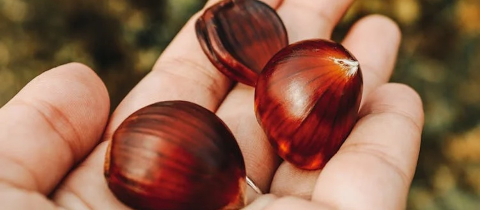Sir Francis Bacon, an important figure in the development of the scientific method, claimed in his work on natural history that when a basil plant was exposed too much to the sun, it became wild thyme. This belief in transmutation has not held up to our expanded knowledge of the world, but there is still something magical and awe-inspiring when we look at the chemistry of the basil plant.
The name “basil” comes from the Greek basilikon, meaning “royal (plant),” itself derived from basileus, meaning “king.” This regal name is thought to have its origin in the belief that basil was used in the making of royal perfumes.
There are many varieties of basil in existence. Perhaps the best known is sweet basil, common to the Mediterranean region. A Thai variety has a spicy hint of licorice, while lemon and lime basil add a citrusy flavour to meals.
To unpack where all of basil’s delicious aromas come from, we have to talk about secondary compounds. Plants require essential substances like water, nitrogen, and carbon dioxide in order to survive. But other substances—often products of the plant’s metabolism—are not vital and they end up accumulating in plant tissues. These are known as secondary compounds. Some will attract pollinators, like bees, while others will repel predators by making the plant bitter to the taste or poisonous. The usefulness of these secondary compounds is not limited to the plants themselves; humans have also learned to put them to good (and sometimes less good) use. Salicylic acid gave us pain relief, caffeine made us more alert, and cocaine gave us Al Pacino’s classic line, “Say hello to my little friend.”
There are many types of secondary compounds, one of them being the essential oils, these aromatic, oil-loving molecules that evaporate easily at room temperature and titillate our olfactory receptors. They are called “essential” not because they are vital to either the plant or us, but because they are said to contain the essence of the plant. The smell and taste we associate with basil come from a number of essential oil molecules that, depending on the species, the cultivar, and the growing conditions, will be present in different quantities in the leaves. Taking a peep at the main aromatic compounds found in basil is in itself a tasty lesson in chemistry.
Basil contains estragole, also known as methyl chavicol. Estragole is a relatively small carbon-based molecule used in perfumes, and it can be found not just in basil but in fennel, pine oil, and tarragon. In fact, the name “estragole” comes from the French name for tarragon, estragon.
In terms of chemistry, a relative of estragole has an interesting magic trick up its sleeve. The technical term for this relative is “isomer.” Isomers are compounds that have the exact same chemical building blocks but arranged differently. Both estragole and its isomer, anethole, can be described as C10H12O (meaning they have 10 carbon atoms, 12 hydrogen atoms, and a single atom of oxygen), but the way in which these atoms are assembled differs slightly, which grants anethole a marvellous property. Anethole is responsible for the distinctive odour and flavour of anise, and while it is highly soluble in alcohol it is only slightly soluble in water. This is why, when you add water to an anise-flavoured liqueur like ouzo, the solution becomes opaque. The anethole spontaneously emulsifies: it suddenly forms a number of small drops that scatter visible light and cloud the liqueur. This is known as the ouzo effect.
If basil’s estragole taught us about isomers, it’s the royal plant’s linalool that can inform us about another interesting property of chemicals. Linalool is added to the scent of a large swath of cleaning agents and perfumed hygiene products, and can be used to repel mosquitoes (more on this topic here). Linalool is what is known as a chiral molecule, from the Greek word for “hand.” There is a version of linalool that is the right-hand molecule and another, its mirror image, that is the left-hand molecule: same atoms in the same order but the two versions are symmetrically flipped. These two chiral siblings are known in chemistry as enantiomers, meaning “opposite parts.” The receptors in our nose can distinguish between these two linalool enantiomers. The left-handed one, (S)-linalool, is sweet and floral, while the right-handed mirror image, (R)-linalool, is perceived as more woody and closer to lavender.
 The complex fragrance of the basil plant, however, cannot simply be reduced to estragole and linalool; there is a whole bouquet of molecules at play. Eucalyptol, also found in eucalyptus oil, brings a cooling taste and minty perfume to basil. Citral provides a lemony freshness to the fragrance and is present in large quantities in both lime basil and lemon basil. Eugenol is full of clove-like spiciness, and the discovery of its anesthetic properties contributed to the development of the potent drug propofol. Finally, methyl cinnamate is reminiscent of both cinnamon and strawberries and helps complete basil’s aromatic profile.
The complex fragrance of the basil plant, however, cannot simply be reduced to estragole and linalool; there is a whole bouquet of molecules at play. Eucalyptol, also found in eucalyptus oil, brings a cooling taste and minty perfume to basil. Citral provides a lemony freshness to the fragrance and is present in large quantities in both lime basil and lemon basil. Eugenol is full of clove-like spiciness, and the discovery of its anesthetic properties contributed to the development of the potent drug propofol. Finally, methyl cinnamate is reminiscent of both cinnamon and strawberries and helps complete basil’s aromatic profile.
Many of these secondary compounds have been found to have some sort of “anti” property: antioxidant, antiseptic, antibacterial, antiviral, antifungal and antiulcer. This may be why the alleged medicinal properties of the basil plant have grown over time, crowning the regal plant as an ostensible cure-all. While reading up on basil, I found myself staring at long lists of health conditions basil could apparently help with: headaches, coughs, diarrhea, constipation, warts, worms, kidney malfunctions, insect bites, acne, fever, throat congestion, stomachache, respiratory problems, intestinal problems, anxiousness, stings, aches, grippe, infections, bleeding, earache, menstrual irregularities, arthritis, anorexia, malaria, diabetes, spasms, and plutonic transmissions. If, like me, you are wondering what a “plutonic transmission” is supposed to be, a helpful Twitter user pointed me in the direction of anthroposophy, a highly suspect hybrid of science and spirituality. Plutonic transmissions seem to be some sort of energy beaming down on us from far-flung Pluto. Basil is such a magic bullet, it can even cure conditions that don’t exist.
But sticking to science, yes, basil may have antiviral activity but it doesn’t mean eating pesto will protect us from COVID-19. Many natural compounds display interesting fighting abilities in the lab when they are put into contact with viruses, bacteria and cancer cells. Similarly, as I wrote earlier this year, ginkgo may well have the ability to inhibit an important molecule that the SARS-CoV-2 coronavirus uses, but we are a far cry from taking ginkgo supplements to fight against the pandemic. Usefulness in the lab does not automatically mean it would be effective inside the human body or safe at the doses required of its medicinal activity. If the regular consumption of basil was really the silver bullet claimed by fans of traditional herbalism, Italians and Thais would hardly ever need to go to the hospital.
While basil’s medicinal claims to fame remain dubious, its usefulness in the kitchen should be indisputable. A helpful tip: those lovely aromatic molecules contained in the leaves are easily lost in cooking. To preserve fresh basil’s potent aroma, it’s best to add it last, just before serving.
Basil may not magically turn into a different herb when the sun hits it just right, but it can transform an otherwise bland meal into a more aromatic experience.
Take-home message:
-The scent and taste of basil are due to varying quantities of aromatic molecules like estragole and linalool
-Isomers, like estragole and anethole, have identical molecular formulas but their atoms are arranged differently
-Chiral molecules, like (S)-linalool and (R)-linalool, are mirror versions of each other and our nose can distinguish them and attribute to them different smells







